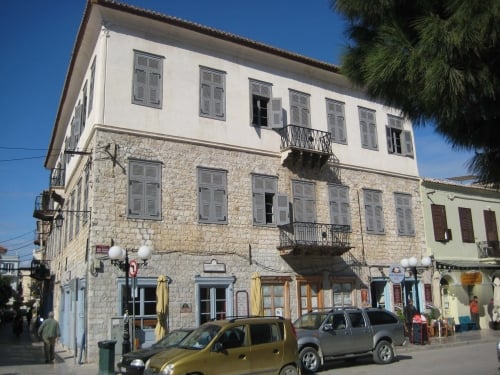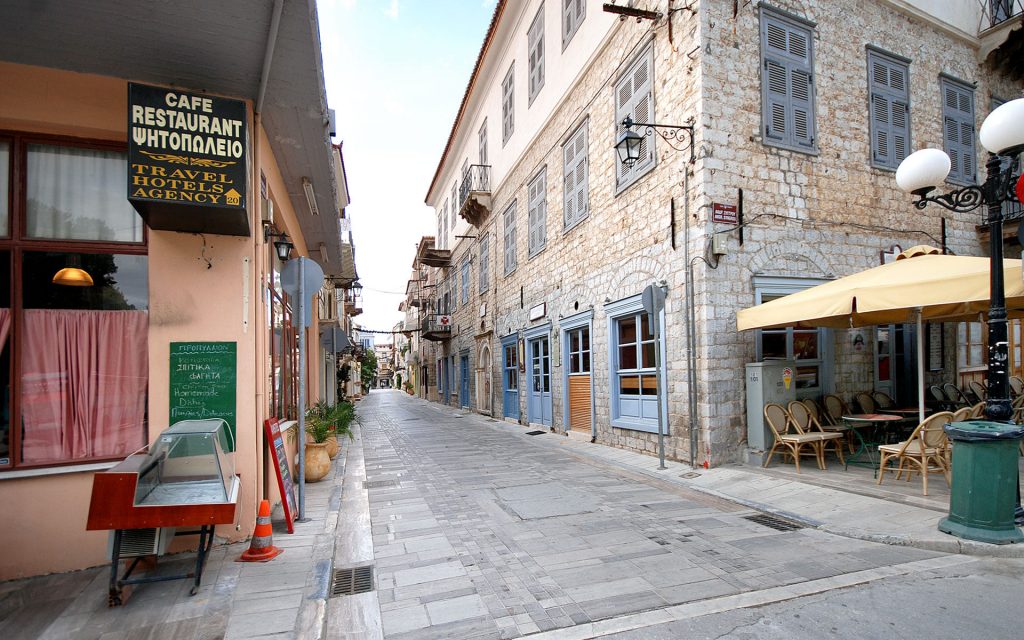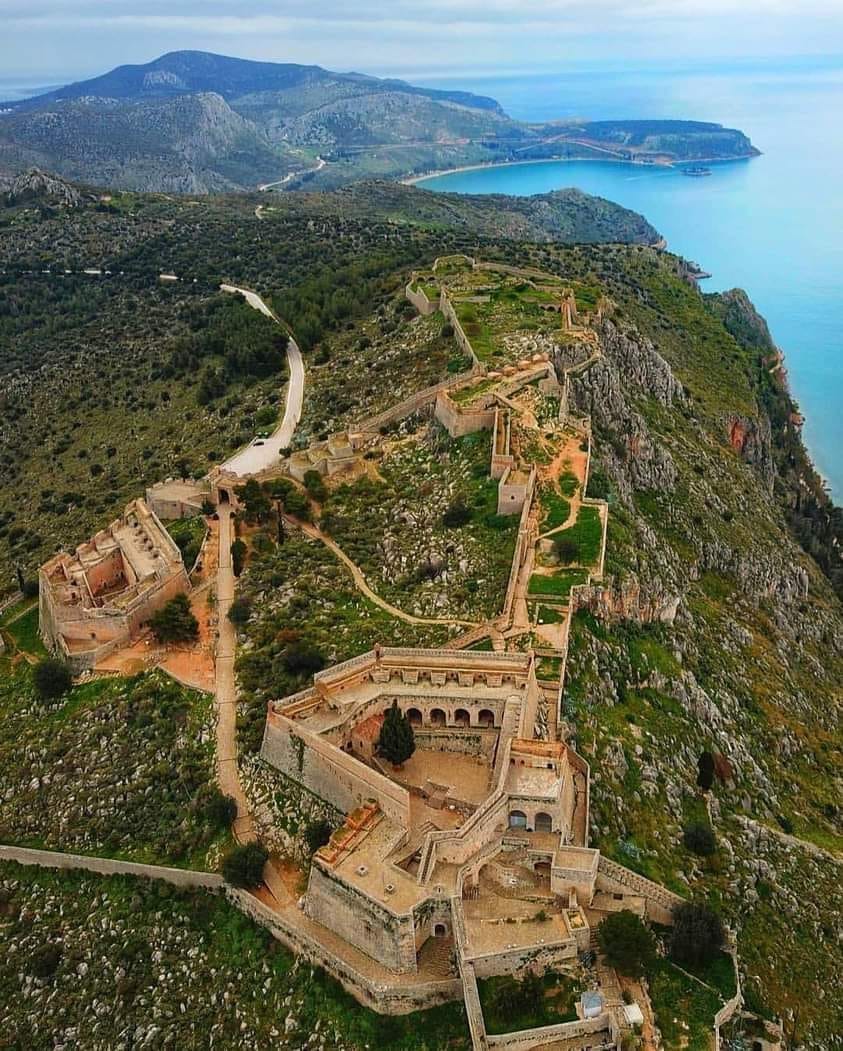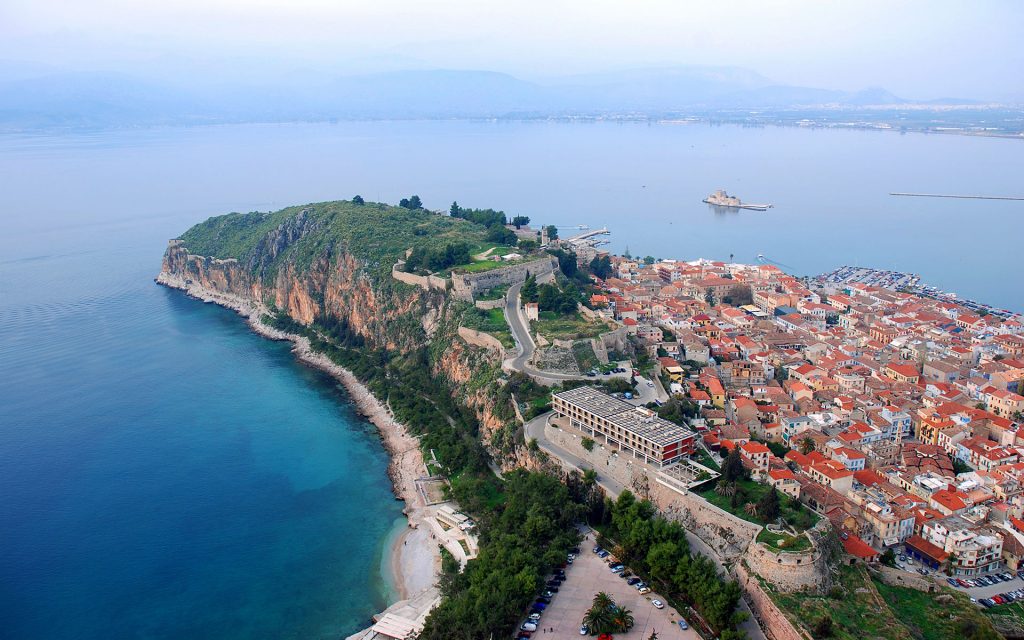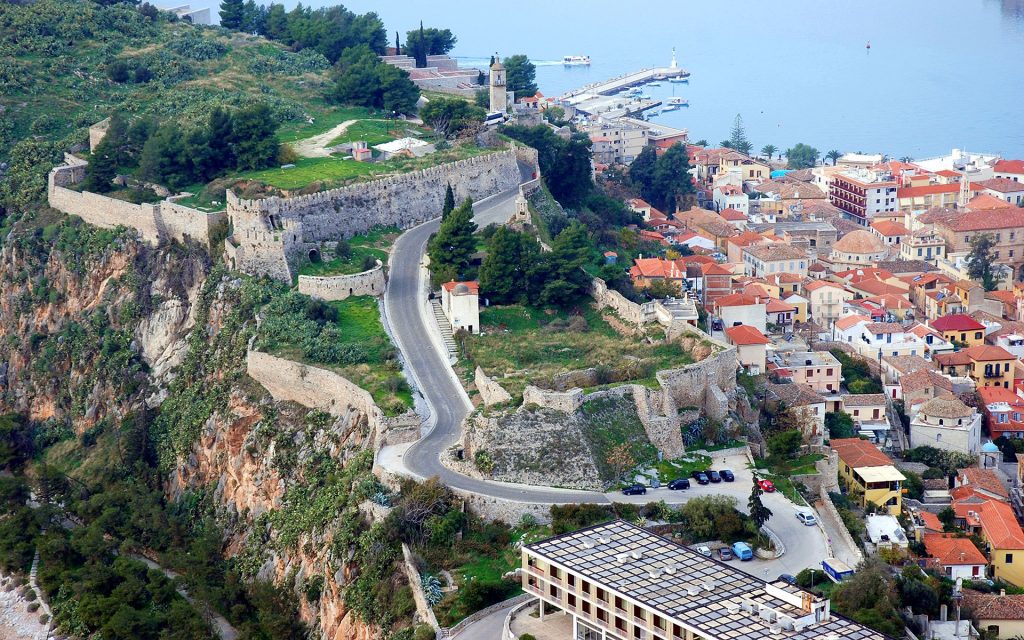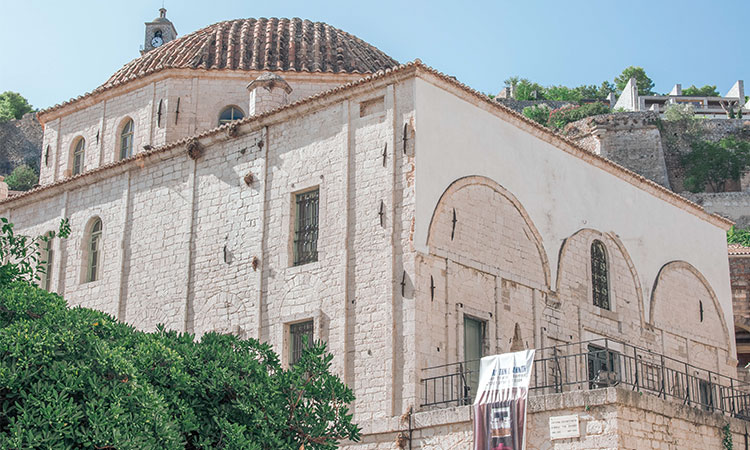Palamidi
The fortress of Palamidi, which owes its name to the Homeric hero Palamidis, is one of the most important achievements of Venetian fortification architecture. It was built in 1687 by the Venetians, after the occupation of the hill on which it is located, after a fierce battle with the Ottomans during the Venetian-Turkish War. During the Greek Revolution of 1821 the Turks fortified themselves in Palamidi but on November 30, 1822 the Greeks occupied it after a battle in which Staikos Staikopoulos the Moschonissiotis and 300 men participated.
After the Revolution, Palamidi served as a prison, in which Theodoros Kolokotronis was imprisoned in 1833 and released 11 months later, thanks to King Othonas.
Today the access to the fortress is possible either through a highway that ends at its eastern gate or from the well-known staircase located on its west side, east of the Grimani bastion. This ladder, which tradition wanted to have 999 steps, because the millimeter was dropped by Kolokotronis’ horse, actually has fewer stairs and was built in the time of Othonas by convicts who were imprisoned in Palamidi, under the supervision of the Bavarian army.
Acronafplia
The rocky peninsula of Acronafplia was the walled settlement of Nafplio from antiquity until the end of the 15th century.
The current form of the castle was completed mainly in the periods of Frankish rule and the First Venetian rule, from the 13th to the 16th century. The existence of the first organized settlement in Akronafplia is attested at least from the end of the 4th c. BC, when the first phase of its fortification is dated by polygonal processed stones, which survive to this day and form the basis of the later walls. During the Turkish occupation it was called by the Turks Its-Kale, meaning inner castle and was inhabited by ordinary people, Turks and Christians, as the residences of the officials were concentrated in the lower city.
In 1686, the Venetians by decree banned residence in the castle of Acronafplia.
In 1829, the Governor of Greece Ioannis Kapodistrias built a large barracks in Acronafplia, as well as a military hospital.
In 1926, the famous prisons that were housed in the barracks of Kapodistrias were transferred from Palamidi to Acronafplia. In 1937 the prisons of Acronafplia became political, which operated there until about 1960.
In 1970-71, the demolition of the prisons began in order to build the hotel “Xenia Palace”, when a significant part of the walls and buildings of the Roman castle and the military hospital were destroyed. The only thing that survived from the hospital is the church of Agioi Anargyroi.
Today one can visit the Castle of Acronafplia either ascending east of Staikopoulos Park and Arvanitias Square, or from the staircase of the Catholic Church and the gate of the Castle of Toros.
Bourtzi
The sea fortress, which became known by the Turkish name Bourtzi, meaning tower, is a trademark of the town of Nafplio. Initially on this islet, located in the middle of the port of the town, there was a Byzantine church dedicated to Saint Theodore. The fortress was built in 1471, by the Venetians by the architect Antonio Gambello and is one of the most important parts of the fortifications of the historic city. The design of the fortress is adapted to the elongated shape of the islet. The center of the fortress is occupied by a tower in the shape of an irregular hexagon, with covered cannons on either side at a lower level. Internally, the tower has three floors and the communication between the floors was done with escalators for security reasons.
During the years of Ottoman rule, the Turks surrounded Bourtzi with the so-called porporela, that is, with an underwater stone dam, so that large ships could not be approached. In the 18th century, the Venetians erected the central tower and almost the entire island was covered with fortifications. During the years of the Greek Revolution, Bourtzi was known as Kastelli or Thalassopyrgos. The Greek government found refuge here in 1826, when the rebellious nation was in a civil war. Bourtzi functioned as a fortress until 1865.
In 1935 the fortress was converted into a hotel after renovations by the German architect Wolf Schaefer.
Today, one can visit Bourtzi by boat from the waterfront of Nafplio.
The Land Gate
The Land Gate was built in 1708 by the French engineer Lassalle and succeeded an earlier gate of the first Venetian occupation. It was the only entrance to the lower city from the mainland and in fact the gate closed after sunset. Anyone living outside was forced to spend the night outside the walls, usually in the suburb of Pronoia. In front of the gate there was a sea moat that surrounded the eastern walls of the city and access to the gate was made by a movable wooden bridge. The Gate was gradually demolished from 1894 to 1897. Only a few architectural members and sculptures have survived from the Gate, such as the stone lion of its crown, which lacks the head, wings and tail, as well as the plaque with the coat of arms. of the Venetian commander Grimani dated 1708.
Today, the exterior of the gate has been reconstructed, following a special study done for its original form.
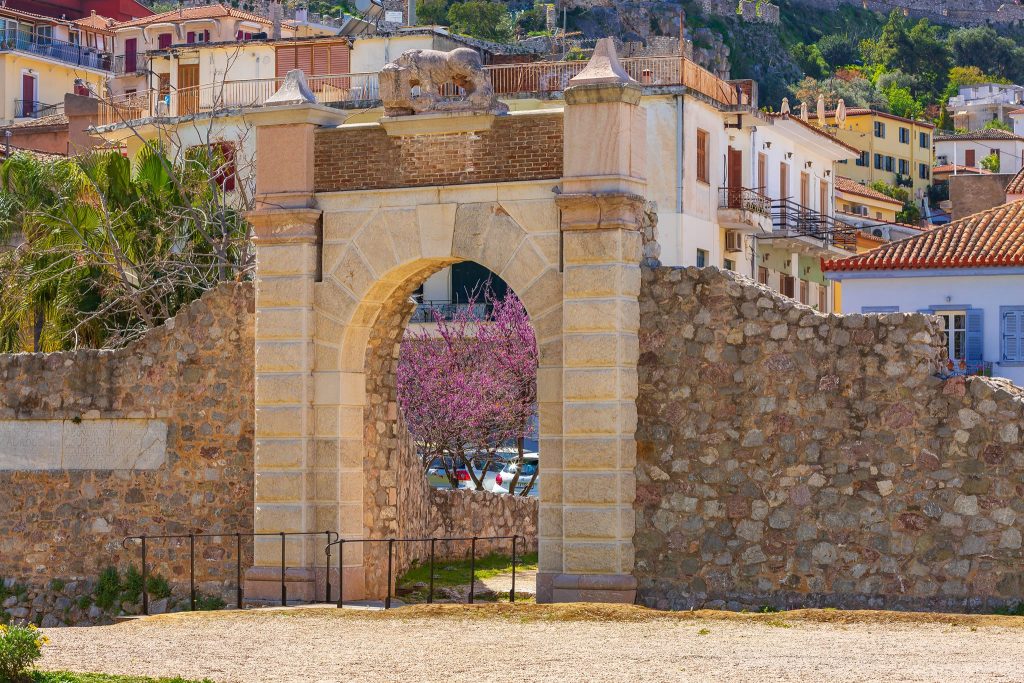
The Five Brothers Bastion
The Five Brothers Bastion is located on the northwest side of Akronafplia and was built to control together with Bourtzi the entrance of the port of Nafplio.
The Five Brothers is a protruding part of the wall from the rest of the wall of Akronafplia, autonomously fortified for the defensive protection of Nafplio on the side of the Argolic Gulf above the Sea Gate.
The construction of the Bastion dates back to between 1389-1540 when Nafplio was under the rule of the First Venetian Empire.
At that time there was the discovery of gunpowder and so they placed special emphasis on the defensive fortification technique of the bastion by placing five heavy cannons and thus it was named “Bastion Five Brothers”.
The Five Brothers cannons that survive in good condition come from a factory in Venice by John Francis Almergeti. In one of the cannons of the bastion the cast manufacturer left the signature of “MARCANTONIO Q. NICOLO΄ DI CONTI FONDITOR PUBLICO D ‘ARTIGLIARIE”.


The Grimani Bastion
he Grimani Bastion or San Antonio is located in the northeast corner of the castle of Toros. Its name comes from the Venetian governor Francesco Grimani and was built between 1702 and 1706 during the second Venetian occupation.
The destination of its creation was the protection of the entrance of Nafplio from the Gate of the Land and the castle of Akronafplia with four cannon stations.
The winged lion of the Venetian Empire can be seen on the north and east walls, which is the symbol of its patron, the Evangelist Mark.
On the north side, along with the walls, the aqueduct of Promachonas Grimani was integrated at a small depth from the surface.
The Grimani Bastion is visible from the Gate of the Land and Staikopoulos Park and is in good condition.
Lion of Bavaria
The great sculptural monument of modern times is located in the area of Pronoia, near the cemetery of Agios Pantos. According to the inscription that accompanies it, it was carved in 1840-1841 with the sponsorship of King Louis I of Bavaria in memory of the Bavarian soldiers who died of typhus in 1833-1834 and were buried in this area. The lion, rendered on a monumental scale carved into the rock, is depicted sleeping. The sculptor of this beautiful monument is the German Christian Ziegel, who was the first professor of sculpture at the Technical University of Athens. The model for Ziegel’s work was the Lucerne Lion by the famous Danish sculptor Bertel Torvaldsen.
Today, the area in front of the Bavarian Lion has been transformed into a small park with benches and is suitable for a short break while touring this part of the city.
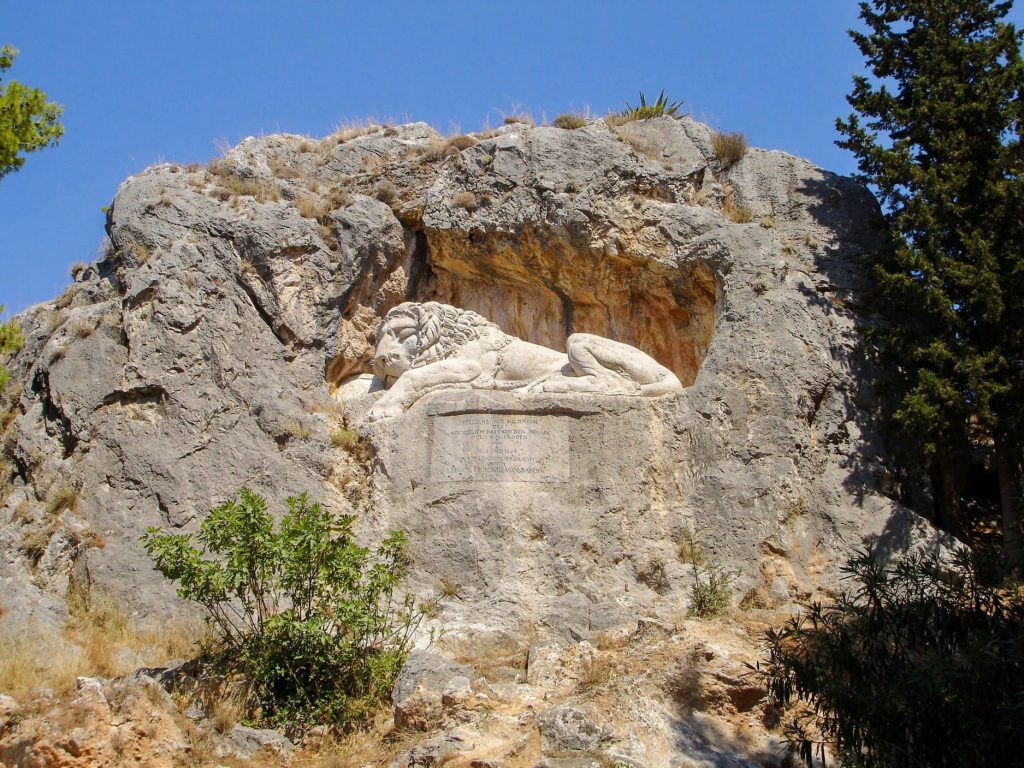
Trianon or Old Mosque of Syntagma Square
The monument that became known as “Trianon”, from the name of the cinema that was housed here, is the oldest surviving mosque in the city and has strong influences from the Byzantine church building. It dates back to the years of the First Turkish Occupation, and is probably the only building that survives from this period in the city. During the years of the second Venetian rule, the mosque was intended for the worship of Catholics. From 1828 until the beginning of 1833, the Mutual School for Boys was housed here, and at the end of the 19th century, the space served as a theater.
Several years later, it operated as a cinema under the name “Trianon”, while in recent years the Old Mosque houses the Municipal Theater of Nafplio.

Vouleftiko
The Vouleftiko building is located in the southwestern part of Syntagma Square. Its construction dates back to 1730, during the years of the second Turkish occupation of the city, and was originally built as a mosque. After the liberation of the city, this mosque housed the Greek Parliament from the autumn of 1825 until the spring of 1826, after it was first properly designed by the architect Ballianos. This was its most important use and with the name “Parliamentary” it has become known until today.
Today, the Vouleftiko has been restored by the Ministry of Culture and serves as a conference room. The Municipal Gallery of Nafplio was recently moved to the ground floor of the Vouleftiko with an interesting collection of paintings by contemporary Greek artists.
Armansberg Mansion
One of the typical examples of classicist architecture is the building known as “the residence of Armensberg” located on A. Syggrou Street with Plapouta. The building was erected during the NW Venetian period. In the time of Kapodistrias it probably housed public services, while later, during the Ottoman rule it was the residence of the regent Arminsberg. In 1831, according to information on the balcony, the third floor was added to the existing building, which has the Kapodistrian palm tree in the corner of the cornice.
